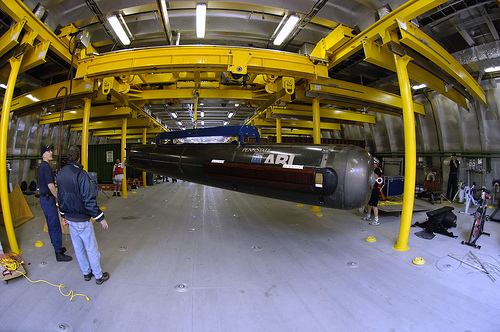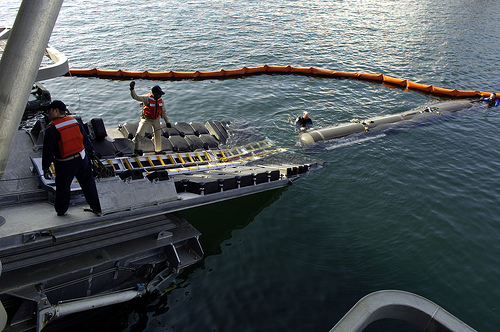Seahorse AUV
The Seahorse Autonomous Undersea Vehicle (AUV) was developed by the Applied Research Laboratory at the Pennsylvania State University (ARL/Penn State) beginnning in April 1999 in support of the Naval Oceanographic Office of the United States Navy (NAVOCEANO). The Seahorse is designed for environmental survey/bottom mapping and its payload includes a multibeam bathymetric sonar, Synthetic Aperture Sonar (SAS), an Acoustic Doppler Current Profiler (ADCP) and a Conductivity, Temperature and Depth (CTD) sensor. Seahorse is a large UUV at 28 feet, six inches in length, and a weight of 10,800 pounds.
In January of 2003, the first Seahorse vehicle successfully launched from the missile tube onboard a Trident Submarine during the Giant Shadow experiment. The Seahorse conducted a minefield survey and a simulated Q-route (cleared shipping channel) survey.

San Diego (January 30, 2006) - The Seahorse-class Autonomous Underwater Vehicle (AUV) from the applied research laboratory at Penn State University is maneuvered into position in Sea Fighter's (FSF-1) mission bay during launch and recovery testing. At 28 feet, six inches, and weighing 10,800 pounds, Seahorse is an untethered, unmanned, underwater robotic vehicle, capable of pre-programmed independent operations. The Office of Naval Research (ONR) sponsors the demonstration. U.S. Navy photo by Mr. John F. Williams (RELEASED)

San Diego (Jan. 30, 2006) - The Seahorse-class Autonomous Underwater Vehicle (AUV) is moved into position with Sea Fighter's (FSF-1) stern ramp during launch and recovery testing. U.S. Navy photo by Mr. John F. Williams (RELEASED)